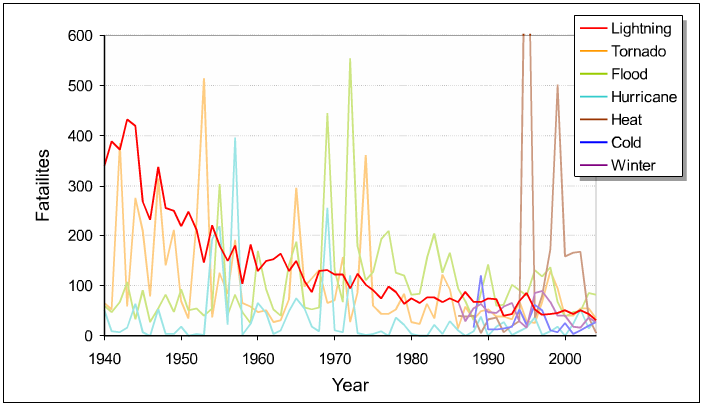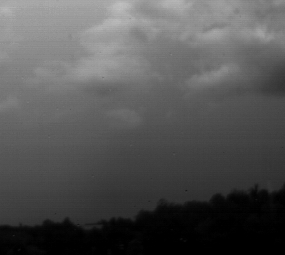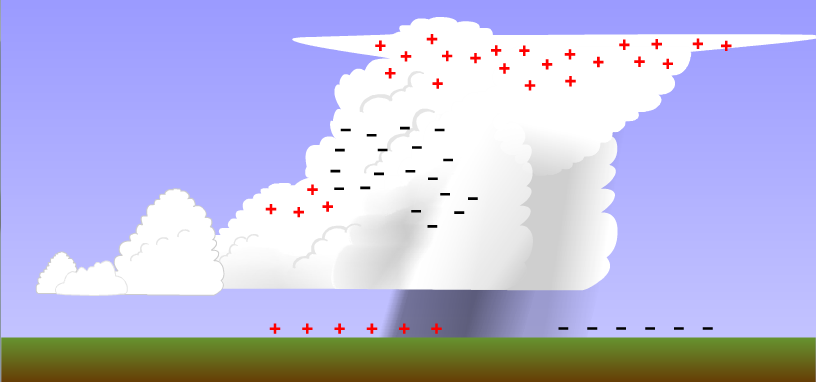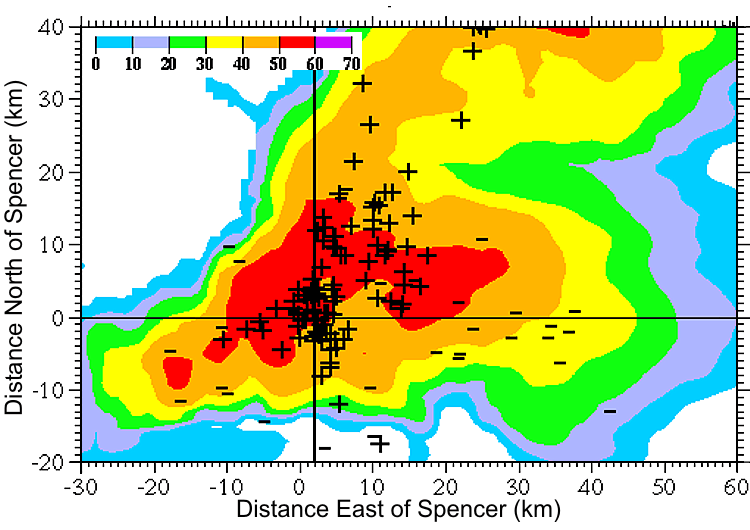Prioritize...
When you've finished this page, you should be able to discuss why fast convective updrafts are required for lightning formation. You should also be able to discuss the myth of "heat lightning," trends in lightning fatalities (who is most often struck and when the greatest risk for fatalities occurs with respect to a passing thunderstorm), and key safety tips for avoiding lightning strikes.
Read...
The annual list of fatalities from severe weather in the United States is compelling (see chart below). Most of the lines show lots of year-to-year variability, and major individual events easily stick out, like the spike of heat-related deaths in 1995, when a great heat wave overtook the Midwest in July, and several hundred people died in Chicago. But, of all the lines on the graph, one really sticks out to me -- the red one representing deaths from lightning. It shows a clear downward trend from 1940, and lightning deaths have settled below 50 per year, on average.

Despite the decrease in lightning fatalities (even while a large increase in population occurred), each year in the United States a few hundred people are struck by lightning and a few dozen die (on average), so there's still work to be done. Of those killed each year by lightning, on average, nearly 80 percent are male. Research suggests that more men may be struck by lightning because they're more likely to be in vulnerable outdoor situations where finding shelter may be difficult (boating, fishing, camping, doing construction work, etc.), and they're too slow (or reluctant) to be convinced of the imminent threat of lightning.
You might think of lightning as a "bolt" from a cloud to the ground, but such "cloud-to-ground" (CG) lightning only accounts for about a fourth to a third of all lightning. Intra-cloud (IC) and cloud-to-cloud (CC) lightning are much more common and account for two-thirds to three-fourths of all lightning flashes. Other, much less common forms of lightning also exist, such as cloud-to-air lightning, and sprites. By the way, you may have noticed that I didn't mention "heat lightning" as a type of lightning. That's because there's no such thing as "heat lightning" (as in, lightning caused by heat). What most people refer to as "heat lightning" is just lightning that's created in a distant thunderstorm (too far away to hear the thunder). I'd imagine that people started using the term "heat lightning" because they noticed lightning without thunder on very warm, humid summer nights as thunderstorms roamed in the distance.

Regardless of the type of lightning, there's much more to lightning than meets the eye. A lightning bolt is not a single "flash in the pan." Lightning is actually quite complex, as the spectacular slow-motion lightning video on the right shows. Here's another slow-motion video of a lightning strike (credit: NOAA) which confirms that there seem to be multiple "parts" to a lightning strike (here's the same video slowed down even more). If you want to read more about the "parts" that make up a lightning strike (namely "stepped leaders," "return strokes," and "dart leaders") check out this series of pages on the anatomy of lightning from the National Weather Service.
Complexities aside, lightning is the difference between a convective rain shower and a thunderstorm. In the most basic sense, lightning is like a spark from a light switch to your finger after you walked across a carpet during the wintertime. Lightning is simply an electrical discharge from a cumulonimbus cloud that occurs when an imbalance in electric charge exceeds the electrical resistance of the air (the electrical resistance is substantial because air near sea level has a low electrical conductivity). As a result of air's high resistance, lightning rapidly heats a narrow channel to temperatures near 50,000 degrees Fahrenheit (resistors warm when electricity passes through them). That's hotter than the surface of the sun! Such intense heating prompts the emission of visible light. Moreover, super-heated air expands rapidly, producing shock waves that are heard as sharp claps or bangs near the strike. Farther away, shock waves give way to sound waves, and peals of thunder reverberate for several miles. So, you can't have a thunderstorm without lightning.
And, if you can't have a thunderstorm without lightning, you can't have a thunderstorm without speedy, convective updrafts. Why is that? Well, for lightning to occur, we need an electric field that results from electrically charged particles, and air rising rapidly thanks to positive buoyancy within cumulonimbus clouds can create a separation of charges as large as several hundred million volts (a million times greater than the voltage in a typical home). Let's first look at the typical distribution of electrical charges in a typical thunderstorm (see image below).

In a nutshell, an area of positive charge develops in the upper reaches of the cloud, while the lower and middle parts of the cloud take on a negative charge as positive charge develops on the ground. How does this distribution arise? Well, truth be told, more than 250 years after Ben Franklin's initial work in 1752, we still do not fully understand the processes by which cumulonimbus clouds become electrified. There are several theories that aim to describe the electrification of cumulonimbus clouds, but I'll only quickly summarize one leading theory, which is based on the idea that the electrification of cumulonimbus clouds hinges on fast convective updrafts above the melting level, which results in collisions between ice particles, causing charge separation.
High up in cumulonimbus clouds, supercooled liquid cloud drops, ice crystals, hail (frozen raindrops), and graupel (also called "snow pellets," which are snowflakes coated with ice that formed as supercooled cloud drops froze on contact) all coexist. The fast convective upward motions cause ice particles to collide and exchange ions (charged particles), and in doing so, they become electrically charged, with graupel taking on a net negative charge and smaller ice crystals a net positive charge. I'm skipping the details, but the bottom line is that heavier graupel, with its net negative charge ends up distributed in the lower and middle parts of the cloud, while smaller, lighter ice crystals with their positive charge, get swept toward the top of the cloud in the storm's speedy updraft. As all this occurs, positive charge develops at the earth's surface, which follows the storm like a shadow, and after the seperation of charges becomes great enough, lightning occurs. So, ultimately, lightning requires speedy, convective updrafts to cause collisions between ice particles and charge separation in the cloud.
Lightning Safety
As visually spectacular and fascinating (at least in my opinion!) as lightning can be, it is extremely dangerous. While about 90 percent of lightning-strike victims live to tell the tale, many survivors suffer permanent disabilities, often from injuries to the nervous system. So, how can you keep yourself safe? Well, make no mistake about it: you are NOT safe outside when a thunderstorm is nearby. The National Weather Service has adopted the phrase, "When thunder roars, go indoors," and those are good words to live by. If you can hear thunder, lightning is close enough to potentially strike you. And, lightning need not directly strike you to injure or kill you. People can be injured or killed by "side flashes," which occur when lightning strikes another object near a person (usually within a few feet) and a portion of the current jumps to the victim. Another danger stems from the fact that when lightning strikes any object, much of the energy travels outward along the ground, and can enter the body where it contacts the ground (most lightning injuries and deaths actually occur from such "ground current"). Lightning can also travel long distances in wires or other metal surfaces (like the plumbing in your home, electrical wires, corded phones, etc.), which provide a path for the lightning to follow. Such "strikes by conduction" through metal objects are the leading cause of indoor lightning injuries and deaths.
When it comes to outdoor lightning fatalities, the greatest risk actually doesn't occur when the storm is right overhead (when most of the lightning is occurring). That might seem odd, but there's a fairly simple reason -- most people have taken shelter by the time the worst part of the storm occurs. As this animation about lightning casualties from NOAA shows, the greatest risk for lightning deaths actually occurs as a storm approaches because people don't take shelter quickly enough (they mistakenly think they still have time before the lightning arrives). A lightning strike to a golf course tree at the 2019 U.S. Women's Open just after the course had been cleared provides a good example. A lightning strike split the trunk of a tree, even though the heart of the storm hadn't arrived yet. Fortunately, the vast majority of people had taken shelter and nobody was injured (those who remained outside were lucky), but it was a close call! There's another spike in casualty risk after a storm passes because people go outside too soon as the storm departs. Keep in mind that some lightning bolts seemingly come "out of the blue," from parts of the cumulonimbus cloud where it's not raining, so even though you think a storm might be over, the risk posed by lightning isn't.

So, if you can hear thunder, you really should head to a safe shelter (a sturdy building or at least a metal-topped automobile with the windows up), and you should remain inside for at least 30 minutes after you hear the last rumble of thunder. Whenever you're involved in an outdoor activity, you should always plan ahead and have a reliable source of weather information. If thunderstorms are in the forecast, keep in mind that you may need to seek shelter at some point. If you absolutely cannot get inside ahead of a thunderstorm, the National Weather Service lists some things you can do to slightly decrease your chances of getting struck:
- Avoid open fields and hilltops.
- Stay away from isolated tall trees (or other tall objects). If you're in a forest, stay near some shorter trees, if possible.
- If you are in a group of people, spread out to avoid the current traveling in between members of the group.
- If you are camping in an open area, set up camp in a low area (valley or ravine, if possible). Your tent will not protect you.
- Avoid water, wet items, and metal objects (like fences or poles).
Certainly being indoors is much safer during a thunderstorm, but lightning can still pose dangers when you're inside. The National Weather Service recommends the following in order to stay safe indoors during a thunderstorm:
- Stay off corded phones (cordless or cell phones are okay).
- Don't touch electrical equipment (computers, televisions, other appliances, etc.) or electrical cords.
- Avoid plumbing (don't take a bath or shower, wash your hands, or wash dishes).
- Stay away from windows and doors, and stay off of porches.
- Do not lie on concrete floors or lean against concrete walls.
If by chance you are with someone who has been struck by lightning, they may need immediate medical attention. Call 911 immediately, and start CPR if needed. Keep in mind that lightning-strike victims are safe to touch (they do not carry electrical charge). I should also note that lightning poses a risk to property, as well, as it can ignite fires and damage household electronics (even miles away from the strike point).
If you're interested in learning more about lightning and lightning safety, I encourage you to check out the National Weather Service Lightning Safety site. The information there could save your life! Now we must tackle the issue of what regions are most susceptible to thunderstorms (and why). We'll explore the climatology of thunderstorms next! Read on.